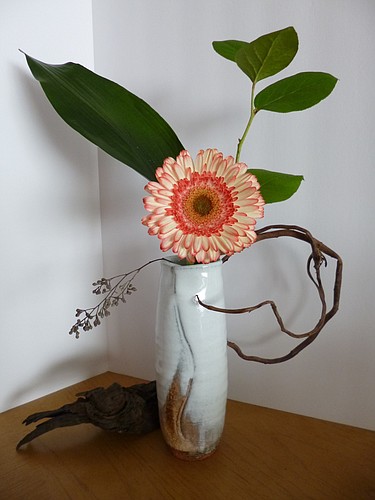- April 3, 2025
-
-
Loading

Have you ever passed a flower arrangement and stopped to consider it as art?
For Terri Ruebusch, an ikebana artist on Longboat Key, flowers are an art form just like watercolors or sculpture, though they won't last as long.
“It’s a very sculptural type of flower design,” Ruebusch said.
Ikebana — meaning “flower arranging” or “making flowers alive” — is a centuries-old Japanese art form that originated as flower offerings at altars. Ruebusch became interested in it after traveling through Japan, like many of her fellow ikebana artists in Sarasota. She’s a dedicated member of the Sarasota Ikebana Chapter, which is affiliated with an international organization.
“The motto for Ikebana International is, ‘Friendship through flowers,’ ” Ruebusch said. “The idea is basically that you come together as a group of friends, and you study the art form, and also other Japanese cultural things.”
Recently, as the coronavirus pandemic kept people indoors and meetings canceled, the Sarasota Ikebana Chapter asked members to create arrangements based on what they had at home, and they edited the images together into one video. Ruebusch, who practices a school of ikebana called “sogetsu,” contributed an at-home design to the chapter’s quarantine video, though she said hers was not as elaborate as some of the others. She lives in Tangerine Bay Club on Longboat Key, so she can’t maintain an elaborate garden like some of her fellow members.
“I work from things that I can grow on my terrace or buy,” Ruebusch said.
In sogetsu, one of the credos is that it can be practiced by anyone, anywhere, anytime and with any kind of material. Throughout her time in siolation, Ruebusch has created several arrangements from what she can get from her small garden, as well as florists. In normal times, her friends with gardens would happily share from their stock, giving her a branch or flower to work with.
“The idea really more is to make an arrangement that maybe mimics nature, borrows from nature, improves upon nature,” Ruebusch said.
In ikebana, Ruebusch said, a lot of the same art concepts from more conventional mediums apply — line, composition, color, mass. A branch or piece of driftwood might be the leading line in a piece, and the prettiest orchid placed in an interesting container, of which Ruebusch has amassed a collection of her favorites.
“It's really a very relaxing thing,” Ruebusch said. “Once you get into your mind what it is that you want to do, it is something you can really kind of shut everything else out because you're so focused on those elements.”
Since you’re working with live materials in ikebana, the piece has to come together fast. Branches and flowers aren’t as easy to manipulate as paint or pencil marks, so making peace with imperfections is often the way to “perfecting” your ikebana piece.
“You kind of have to deal with, for example, if you want a branch to stand a certain way, and it's not gonna stand that certain way, you either have to give up, or find another branch, or go with it,” Ruebusch said. “At some point you say, ‘I'm just letting go of it and working with it as it is.’”
Ruebusch is proud to be part of the local ikebana community, which she said is dedicated worldwide. There are only about 7,000 members of ikebana chapters worldwide, but she’s always hoping to meet new people to share in the art.
“We're very global now, and there's a lot more interest in that sort of thing,” Ruebusch said. “A lot of people aren't familiar with it, but if you go into a good florist … you get really a little crossover between what is Western design, and what we see coming out of Japan and Asia, in terms of how they handle some of the materials.”